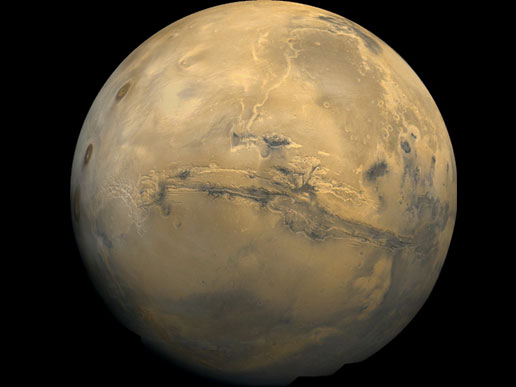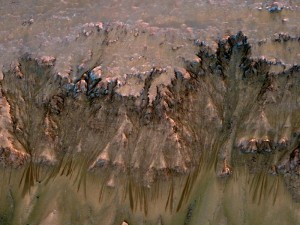Creation Corner
Water on Mars – a challenge

The finding of water on Mars has started a debate on where it came from, how much Mars holds, where it lies, and how long it has lain. Now someone who has taken part in that debate for many years has weighed in.
The water on Mars debate

The inside wall of Newton crater on Mars shows an apparent seasonal flow of salty water down the wall. Photo: NASA/JPL/Caltech
The facts about water on Mars, incredible as they might seem, are not in dispute. Water has flowed on Mars, intermittently, for many years. The Mars Global Surveyor found the first signs: gully-like formations on crater walls. The Spirit rover sent back evidence of recent water flows, before its radio failed forever. Now comes clear evidence, from the Mars Reconnaissance Orbiter, that water flows down cliff faces and crater walls (those that face the Martian equator) every summer on Mars.
So: water on Mars exists. But where did it come from? Water cannot flow or stand constantly on the surface. Mars is far too cold for that (eighty degrees Fahrenheit below zero). So either it forced it way up from deep underground, or fell on Mars from above.
Either theory must explain these details:
- Water flowing on the ground, on the equatorial faces of high mountains and crater walls.
- Salty water.
- Stratified “topsoils.”
The conventional theory
Mr. Alex Morgan left this summary of the conventional theory on this comment space yesterday:
We know that there is water underneath the surface of Mars due to observations from orbiting spacecraft. This frozen water exists at depths very close to the surface (under a meter). We know this because landers (such as Phoenix) saw this water shortly after landing. It is unknown whether Mars has an active core or not, but the heat likely comes from impactors (asteroids, comets and the like), which provide energy to heat the ice. This heat can continue heating the ice for tens of thousands of years after the impact. This is known as a post-impact hydrothermal (PIH) system.
As this is practically universally accepted by the scientific community, there are a number of papers on the subject. Here are a few I would recommend:
Barnhart, C.J., Nimmo, F., Travis, B.J. Martian post-impact hydrothermal systems incorporating Freezing. doi:10.1016/j.icarus2010.01.013
Fassett, C.I., Head, J.W. Sequence and timing of conditions on early Mars. doi:10.1016/j.icarus.2010.11.014
Thorsos, I.E., Newsom, H.E., Davies, A.G. Availability of heat to drive hydrothermal systems in large martian impact craters. LPSC 2001 abstract
Wang, C., Manga, M., Wong, A. Floods on Mars released from groundwater by impact. doi: 10.1016/j.icarus.2004.12.003
Schulze-Makuch, D. et al. Exploration of hydrothermal targets on Mars. doi: 10.1016/j.icarus.2007.02.007
Note: the first of these Digital Object Identifiers does not resolve. The others do resolve. (Editor’s note: one wonders where Mr. Morgan got all these doi numbers. The most popular on-line publication that uses the doi system regularly is Wikipedia.)
The problem: those papers give evaluations only, not new facts. “We suggest,” says the second abstract. That’s what all the authors of those papers do: suggest.
More important than what they suggest is what they assume. They assume that Mars is very, very old. (Though this does not relate to the water on Mars debate, one paper assumes that Mars once had a strong magnetic field, and a “dynamo” to produce it. How that “dynamo” wound down, no one has ever explained.)
The Wang paper comes closest to the truth: impacts from above will heat whatever water is in the ground and make it flow. But the local flash floods on Mars did not come from groundwater alone. This again begs the question of where the groundwater came from. If it pushed up from a very deep aquifer, it would have frozen within a mile of the surface.
Finally: universal acceptance of any theory does not by itself make it true. The history of science is full of theories that scientists of one age all accepted, but scientists of the next age discarded.
The Hydroplate Theory
Walt Brown has an alternative: the Hydroplate Theory. What happened on Mars followed directly from what happened on earth about 4400 years ago. That event was the Global Flood.
The Flood was not simply an ocean suddenly overflowing its banks. It was a subcrustal ocean breaking through a crack in the crust. Through that crack, a tremendous jet of water shot up into the stratosphere and beyond. About one percent of the total weight of the earth, as water, rock and mud, escaped into space. Comets, asteroids, and meteoroids formed from this material.
The future asteroids (except for some “near earth objects” that never left the region of earth’s orbit around the sun) traveled out toward Mars and beyond. But many of those objects fell onto Mars. They delivered an amount of water about twice that of Lake Michigan. And, as meteoric impacts tend to do, these strikes threw large amounts of dirt into the thin air on Mars. This dirt mixed with the melted water and fell back as muddy rain. Eventually it dried—and stratified, because it sorted itself into layers, another thing that suspensions tend to do.
The debate challenge
Your editor shared with Brown Alex Morgan’s comments about water on Mars. Here is his reply:
Alex Morgan needs to provide calculations and a lot more information if he is claiming that impacts tens of thousands of years ago (or even ten years ago) explain the water that has flowed on Mars during the past few years. I don’t believe it.
Infrared images of Mars should show many cooling hot spots where impacts have occurred over the past tens of thousands of years. Where are those pictures?
Of course there is water ice just under Mars’ surface. Morgan and I agree on that. What is Morgan’s source for the water? How does he get drainage channels down the central peak of an impact crater? I have provided more than a dozen top-of-the-line references to support what I am saying. Science reported volume flow rates of 10 – 1,000 million cubic meters of water per second in order to carve some of the erosion channels on Mars. [“Carving them, researchers calculated, would take water gushing at 10 million to 1 billion cubic meters per second.” Richard A. Kerr, “An ‘Outrageous Hypothesis’ for Mars: Episodic Oceans,” Science, Vol. 259, 12 February 1993, p. 910.]
I am not surprised that some people, faced with the shocking fact that salt water has flowed within the past few years (if not during the last summer) have proposed that impacts tens of thousands of years ago could explain it. As Richard A. Kerr noted, “Outrageous Hypotheses” are having to be proposed. Nor am I surprised that Icarus might publish them.
If any of the four papers Morgan references go through the heat transfer calculations (and Morgan claims he understands and concurs with those calculations), I would be willing to read those papers and discuss them with him. He can also call me if he is willing to explain himself in more detail, but before he does, he should read what I have written on the subject. I can’t take the time to explain it to him. Nor am I impressed with someone who provides no details and says, “Just read certain papers or a book and you will understand why I am right and you are wrong.”
If Morgan has written a detailed explanation of whatever he is claiming, I would be happy to read it. He can forward copies to me.
When Morgan writes, “It is unknown whether Mars has an active core or not,” is he saying that maybe a hot core and volcanic eruptions on Mars melted water ice and explains the flows? If so, I would like him to show me where recent volcanic eruptions have occurred on Mars. Speculations on Mars having “an active core” should not enter the discussion. Let’s just deal with solid evidence.
Finally, if Morgan thinks he has a strong case and he is willing to state it in front of an audience, he can always accept my [long-standing telephone debate] offer.
The comment space will remain open to Alex Morgan, should he decide to make a counter-reply.
Featured image: a mosaic of Mars from the orbiters of Project Viking. Photo: NASA/Johnson Space Center. See here for guidelines for use.
[amazon_carousel widget_type=”ASINList” width=”500″ height=”250″ title=”” market_place=”US” shuffle_products=”True” show_border=”False” asin=”1878026097, 0890515077, 0310234697, 0875523382, 0890511586, B002RBHDFK, 0949906689, 0890513600, 089051416X, 0890515050″ /]
Terry A. Hurlbut has been a student of politics, philosophy, and science for more than 35 years. He is a graduate of Yale College and has served as a physician-level laboratory administrator in a 250-bed community hospital. He also is a serious student of the Bible, is conversant in its two primary original languages, and has followed the creation-science movement closely since 1993.
-

 Executive4 days ago
Executive4 days agoSecret Service chief gets no solace
-

 Executive3 days ago
Executive3 days agoWaste of the Day: Louisville Taxpayers Pay Nearly $600,000 For Empty Building’s Maintenance, Security
-

 Guest Columns5 days ago
Guest Columns5 days agoFear Itself: Democrats’ Favorite Strategy Caused Their Current Chaos
-

 Executive3 days ago
Executive3 days agoWhere is Joe Biden – or Jill?
-

 Executive2 days ago
Executive2 days agoWaste of the Day: Throwback Thursday: Cities Used Crime Prevention Funds on Soccer Games, Paper Shredding
-

 Executive2 days ago
Executive2 days agoFacile and politically motivated suggestions
-

 Civilization5 days ago
Civilization5 days agoBuild Iron Dome in the United States To Prepare for Israel’s Worst Day
-

 Executive2 days ago
Executive2 days agoBiden makes farewell whisper















I am sorry that the DOI did not work for you, but the first paper is actually available free of charge on Dr. Nimmo’s website (www.es.ucsc.edu/~fnimmo/website/Mars_hydrothermal.pdf). One shouldn’t need to wonder where I got the DOIs from, as they are listed on the front page of each respective paper. Anybody with access to a database such as JSTOR can easily access these.
First of all, I am not going to go for a debate over the phone for the same reason that a geographer would not debate someone who believes that the world is flat. It would be a pointless argument, since neither of us would have any idea just how it is that the other could believe what he does, and as such we would have no common ground on which to base the debate. I also don’t really see the relevance of a debate when dealing with matters of science, as it doesn’t really matter what conclusion an audience comes to when they hear two scientists debate. What matters is the prevalent opinions of the scientific community.
Second, I believe your editor is in the wrong about his opinion of what scientists actually do. Scientists look at the data, and then suggest an explanation for whatever it is they observe. They do not just state facts, if that were the case then we could all be easily replaced by machines. So yes, in most of these papers the respective authors state several facts from the relevant literature, and then propose a process that could explain such phenomena. A couple of those papers show the results of modeling efforts, which do provide new “data”, although it is up to the reviewer and/or the reader to judge the relevance and quality of the methodology used.
How Mars’ dynamo wound down has actually been explained in numerous papers (a search for “Mars dynamo” in Google scholar will provide one with several examples). Earth’s dynamo exists due to our convecting liquid metal outer core (if you’re really interested in the subject read up on Gary Glatzmeier, a planetary scientist at the University of California, Santa Cruz). If the core were to cool to a sufficiently low temperature, the convection would cease (since the heat differential would be too small to allow for convection). Since Mars is considerably smaller than the Earth, it would have cooled far more rapidly.
I’d really suggest that you actually read the papers before critiquing them. The Wang paper is not about subsurface ice being heated. The abstract, which is a whopping three sentences, explains this very concisely. The paper deals with liquefaction, which is an entirely different process than heating from a kinetic energy source. What you mention (“impacts from above will heat whatever water is in the ground and make it flow”) is the main topic of the Barnhart paper, in which a computer program was used to model heat flow in a freshly created impact crater.
You say that we should stick with solid evidence. It has been some time since I read through scripture, but if I remember correctly the Bible does not mention anything about a Great Flood on Mars. So not only are you basing your argument off a book that may or may not be entirely factual (it may be the word of God, but man put it down on paper, and work of man is by definition fallible), but you are literally adding things to it that it doesn’t explicitly mention. To be frank, that strikes me as hubris.
Not to mention, while you tell me to look up facts, your only citation is Kerr’s paper, which is just a critique of another paper. I am not downplaying the quality of the article, but it does not provide many “new facts”, as you and the editor are so interested in.
No, I am not an atheist, if that is what you are wondering, although I do not believe that ones faith should be confused with their idea of truth. When Galileo created a telescope and observed Jupiter’s moons, he was jailed by the Church, since it had been determined that there were only 7 things in the entire universe (Earth, Moon, Sun, Mars, Venus, Jupiter, Saturn), so anything that saw it as otherwise had to be the work of Satan. The history of religion is also filled with ideas that theologists of one age accepted, but those of the next age discarded.
Now, allow me to finally get to my thoughts on your actual theory…In regards to this “hydroplate theory”, are you really proposing that all comets and asteroids formed from material that erupted from Earth? So does this include the asteroid belt, Tojans, Centaurs, Hildes, and Kuiper belt objects? What about objects within the Oort cloud? And how exactly is it that if all of these objects were ejected from Earth at the same time, they were able to spread into dozens of groups in entirely separate orbits spreading over tens to hundreds of astronomical units? Not to mention the velocity with which they erupted must have been phenomenal in order for them to not be re-captured by Earth’s gravitational field. If this theory is proven true, then every single planetary scientist and astrophysicist I know of would likely need to re-take every course since there first year of undergraduate university.
Since we are only dealing with solid evidence here, I would love to see the calculations that you used to come up with such an amazing discovery!
First and foremost: the Hydroplate Theory did not start with me. (This is the editor talking.) It started with Walter F. Brown of the Center for Scientific Creation in Phoenix, Arizona. He has studied this issue far longer than have I. As far as I can tell, he has come up with the most comprehensive unified theory of creation and the Global Flood that I have ever seen.
In order to judge his theory intelligently, you have to read his entire book from beginning to end. The reason: questions that some parts of it are likely to raise in your mind, other parts will answer. Brown never stops refining his theory.
And it is a true theory. Brown makes predictions from it. And subsequent discoveries have vindicated him. I don’t think that any discovery has yet surprised him completely.
This might surprise you: while Brown makes sure never to contradict Scripture in constructing a narrative of ancient events, he does not rely primarily on Scripture to show that events like these took place. Anyone who does agree to debate him, must agree ahead-of-time not even to invoke Scripture, whether Holy Scripture or anything else, from any other tradition, that pretends to that title.
Brown does indeed propose that all comets, asteroids, and meteoroids formed from material that escaped into space from the earth. That definitely includes the asteroid belt, the Trojan asteroids, and comets, both short-period and long-. The Kuiper Belt is something else again—but he rejects the Oort Cloud, for reasons that he makes clear in his book. There is no Oort Cloud, and never was. First of all, Jan Oort never saw any such Cloud, and neither has any other astronomer or mission controller at JPL/Caltech or Goddard or the ESA or RKK Energia (Russian) or JAXA, etc. Second of all, Brown has a catalog of observations that any unified theory of comets must explain. That includes many things that an Oort Cloud cannot explain.
Phenomenal speed? Seven miles per second. Easily attainable when you consider the tremendous violence of the original break-out event that produced a water jet that arced into the stratosphere.
Let’s consider these “dozens of groups.” That’s just it. The comets orbit the sun in randomly oriented orbits. And the periods are either short or long, and rarely, if ever, in-between. The long-period comets are long because much of the solar system’s total mass is in the Kuiper Belt. Once a comet passes through the Belt, it is subject to the combined gravitational attraction of all the Belt objects, in addition to anything else. So it turns around and falls back, and fast. Fast enough to look as though it has a period longer than six thousand years. Comet Elenin is one such object.
Read the book carefully. You will find, as I did, that it explains much that other theories cannot explain.
Thank you for the prompt response, I am enjoying the discussion.
I would like to raise the issue the Dr. Brown does not have a degree in the physical sciences. Unless I am mistaken his degree is in mechanical engineering. Would you entrust a geologist to instruct you on the inner workings of machinery? Or a physicist to perform surgery? I sure wouldn’t. In the same regard I would not trust a mechanical engineer when it comes to the workings inside of planets (which is the realm of geologists).
If Dr. Brown’s research were to be published in a peer-reviewed journal (such as Icarus, GRL, Science, Nature, etc), I would gladly read it. However, just because there something is in print does not make it factual. Like I said, Brown is not a geologist, planetary scientist, or astrophysicist, so I am a bit skeptical of his knowledge on the subject. Brown has created this theory in order to justify a process that is described within scripture, whereas traditional scientists create theories that are based purely off of observation, without any need to call in the supernatural to explain them.
Brown presumably bases his theory off of data that has been collected by other scientists. The overwhelming majority of these scientists disagree with his claims. By that, I mean NASA, JAXA, ESA, and every single university with a astronomy or planetary science department that I have ever heard of. Surely there must be a reason that tens of thousands (at least) of scientists from across the globe have this opinion?
Ask all those scientists what their reasons are. And I mean, really ask them. Make sure, before you do, that you understand the issues.
Creation scientists—and semi-professional journalists like me who cover their movement—agree fully with the facts that these aerospace scientists gather—with the facts, but not with the typical evaluation of them. The reason is that, quite apart from what Scripture says, those evaluations, and suggestions, don’t make sense.
Brown actually bases his theory as much on his own observations (he has been up and down the length of the Grand Canyon, for example) as on the data from astronomers, Project Apollo, and the many unmanned rocket probes that humans have launched. And you don’t need a degree in the physical sciences to know that the typical explanations don’t make sense. All you need is a good, solid grasp of higher mathematics. His book lays out those mathematics.
To stick to the subject of water escaping from earth, he has shown how the tremendous “water hammer” can make that possible. Read his book, and all will become clear.
Now if you are afraid to—well, I will merely ask you to ask yourself why. If you, who presumably are a university professor, find yourself not willing to consider whether his theory might be correct, ask yourself what unwritten law of the scientific community you are afraid that you might violate.
Now about those traditional (make that conventional) scientists: Real science does indeed start with observation. But sometimes you observe something that takes an intelligent actor to bring about. If you discover a pocket watch lying on a hilltop, you do not assume that the pocket watch formed there by long and involved, purely wild processes. You know when you see it that somebody built it, and someone else dropped it there by accident.
Why, then, do you accept the proposition that something far more intricate, namely a living cell, self-assembled? Do you really believe that the information in any cell, that would fill ten Libraries of Congress, wrote itself?
You mentioned liquefaction. Well, as a matter of fact, liquefaction plays a role in the hydroplate theory. Liquefaction plumes exist at multiple sites. But why does everyone ignore their implications? You need high-magnitude earthquakes to get liquefaction.
Why do you think we have the Mid-Atlantic Ridge in the Atlantic, and directly opposite that formation, you have—the Challenger Deep? For that matter, how do you suppose the Ridge got there?
As I said: ask those “tens of thousands” why they hold to their billions-of-years narrative. Don’t ask us. We cannot speak for them. And we do not seek the numbers of adherents to a theory as an attestation of the truth of that theory. Surely you recognize that as a logical fallacy: argumentum a numeris or argumentum a multitudine. Not to mention argumentum ab auctoritate.
And don’t forget that other time-honored logical fallacy that I see so much of: ratio circularis.
How do we know it’s water and not some other liquid?
The question you asked suggests another: what other liquid could it be? I assume that the data from Spirit and Phoenix, all of which are in the public domain and readily available, more strongly support water, with a lot of salts held in solution, than any other liquid.